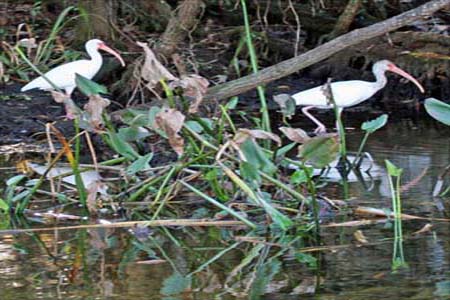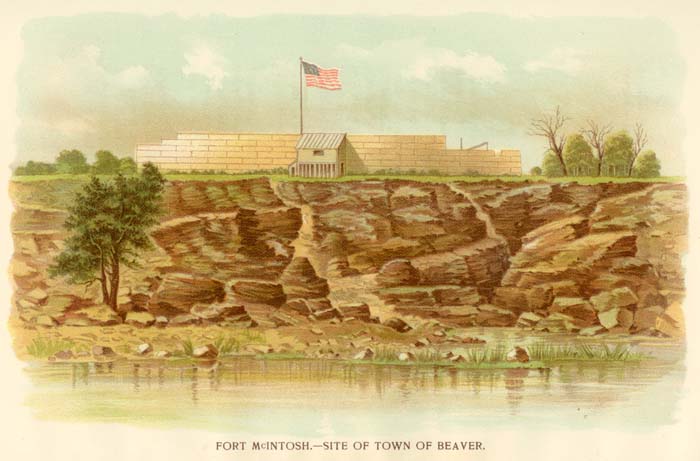 |
 |
|
Photographs (left to right): Ibis, Florida; Alligator; Florida; Great Flood Megaripples, Washington
Wampum Belt Archive
Fort McIntosh 1785 Treaty

Fort McIntosh 1785
Site of the Town of Beaver, PA
Courtesy: US Government War Archives
http://www.usgwarchives.net/pa/1pa/1picts/frontierforts/ff35.html
Original Size: |
|
Reproduction: |
|
Beads: |
|
Materials: |
|
Description (US Government War Archives):
In speaking of the treaty of the State with the Indians made at Fort McIntosh in January, 1785, the Hon. Daniel Agnew says: (34.)
"By a treaty made at Fort Stanwix (now Rome, N. Y.), on the 5th of November, 1768, between the Penns and the Six Nations, the Indian title was extinguished westward by lines which became the eastern boundary of the territory included in the next treaty with the Six Nations, made at Fort Stanwix, on the 23d of October, 1784, by commissioners of the State of Pennsylvania. There were certain tribes in Western Pennsylvania not parties to the treaty of 1784, chiefly Wyandots and Delawares, then actually occupying the western territory. It became necessary to obtain the relinquishment of their title, in order to quiet the Indian claim to the lands included in the treaty of October 23, 1784. The treaty of the Pennsylvania Commissioners with the Wyandots and Delawares at Fort McIntosh, terminated in a deed dated January 21st, 1785, conveying the Indian title by the same boundaries contained in the treaty of October 23, 1784."
"Thus," in the language of Justice Agnew in his monograph on Fort McIntosh, "we have seen that, almost forgotten by the public, and its site scarcely recognizable now, Fort McIntosh was once a place of note, and the scene of important operations and events. Little over a century has passed, and few now can estimate the change. Then a wilderness where red men roamed and a tomahawk and scalping knife gleamed— now a population of 50,000 souls fill the small county of Beaver, crowded with mills and factories."
Question: Was there an exchange of treaty belts?
Fort McIntosh Treaty 1785 https://en.wikipedia.org/wiki/Treaty_of_Fort_McIntosh
The Treaty of Fort McIntosh was a treaty between the United States government and representatives of the Wyandotte, Delaware, Chippewa and Ottawa nations of Native Americans. The treaty was signed at Fort McIntosh (present Beaver, Pennsylvania) on January 21, 1785. It contained 10 articles and an addendum.
In a follow up to the Treaty of Fort Stanwix (1784), where the Seneca nation had given up claims in the eastern extension of Ohio Country in northern Pennsylvania, the American government sought a treaty with the remaining tribes having claims in the Ohio Country. The United States sent a team of diplomats including George Rogers Clark, Richard Butler, and Arthur Lee to negotiate a new treaty. In January 1785, the representatives of the two sides met at Fort McIntosh at the confluence of the Ohio and Beaver Rivers.
Connecticut (Western Reserve in the northeast) and Virginia (Military District in the central south) had residual claims in Ohio Country and would have to be distinguished from Indian Country. Among the only known incursions of the Whiteman in Ohio Country were the U.S. revolutionary fort Fort Laurens in the east, and the old British trading post, Fort Pickawillany in the west.
Essentially, the treaty carved a large Indian reservation out of Ohio Country, whose boundaries were the Cuyahoga and Muskingum rivers in the east, a line between Fort Laurens and Fort Pickawillany (Piqua) in the south, the Great Miami River and St. Mary's River in the west, and Maumee River and Lake Erie in the north. The area comprised about 1/3 of modern day Ohio in the northwest, and a wedge of eastern Indiana extending to Kekionga (future Fort Wayne). Areas outside the boundary in eastern and southern Ohio belonged to the Whiteman. The tribes also ceded areas surrounding Fort Detroit and Fort Michilimackinac to the United States and gave back captives taken in raids along the frontier.
Most Ohio Country tribes did not subscribe to the treaty, particularly the Shawnee who lost all of their lands in southwestern Ohio. The treaty seeded the formation of the Western Confederacy later the same year. Settlers as well as Indians encroaching on the boundary line presaged the Northwest Indian War. An almost identical Treaty line, except the extension in Indiana, was later circumscribed in the Treaty of Greenville following the conclusion of the war.
Fort Stanwix 1758 Massachusetts Historical Society - A Set of Plans and Forts in America, 1765 |
Reference:
US Government War Archives: http://www.usgwarchives.net/pa/1pa/1picts/frontierforts/ff35.html
 |
 |
 |
 |
 |
 |
 |
 |
|---|
